Waxing is a car care process that has been around since the early 1900s. The earliest waxes were made from natural ingredients like beeswax, carnauba, and lanolin. Modern-day car waxes are made with synthetic chemicals and compounds that provide the same benefits as natural waxes but are more durable and easier to apply.
What is Car Wax?
Car wax is a substance that can be applied to the surface of a car to protect it from the elements. It can also be used as a finishing product to give your vehicle a glossy shine.
The main ingredients in car wax are silicone and resins. These ingredients help make up the protective layer that prevents water from penetrating into your car’s paint.
Why Do You Need Car Wax?
Car wax protects against UV rays and moisture damage by forming a thin layer over your vehicle’s paintwork. This prevents water spots from appearing on the paint after driving through puddles and streaks from forming if you drive through rain or snow.
In addition to protecting your car from environmental elements, car wax also helps keep dust from sticking to its surface, as well as preventing oxidation (which causes rust).
Car waxes can be divided into two broad categories: synthetic and natural. Synthetic waxes are made from petroleum products, while natural waxes are derived from plant or animal sources.
Synthetic Waxes
Synthetic waxes have become more popular in recent years as people learn about their benefits and disadvantages. The most common type of synthetic wax is polymer-based, which means it contains long chains of molecules that cling to the surface of the vehicle’s paint. This is also known as “liquid sandpaper.”
These polymers create a very thin layer of protection against environmental elements such as UV rays and dirt, but they do little to prevent scratches or chips on the surface of your car’s paint job.
Natural Waxes
Natural carnauba wax is the most popular type of car wax because it provides excellent protection against UV rays and other environmental elements. It also adds a glossy shine to your vehicle’s paint job that can last for months at a time (depending on how often you wash your car).
This type of carnauba-based product is typically applied by hand with an applicator cloth or by machine, and it helps fill in small scratches that result from everyday driving.
Both synthetic and natural waxes can be further divided into the following forms/mediums:
1. Paste Wax
Paste waxes are the most traditional type of car wax. They are made from natural ingredients like tree sap or shellac and have been used for hundreds of years. They were originally developed as an alternative to liquid wax because they don’t drip like liquids. Paste waxes come in blocks that can be heated in the oven for application.
Once applied, paste waxes protect your vehicle’s paint job by forming a barrier between it and the elements that can cause damage over time.
One disadvantage of using paste wax is that it may leave some residue on the surface of your car’s paint job if you don’t remove it properly after applying it. This residue can get caught between crevices and later cause swirl marks.
2. Liquid Wax
Unlike paste waxes, liquids don’t need to be heated up before application, which makes them easier to use than pastes in most cases. They also tend to last longer than paste waxes, which is a plus if you don’t want to have to reapply the product often.
The downside is that liquid waxes tend to wear off faster than other types of products because they don’t contain enough polymers to bond well with your paint. If you’re looking for an easy way to add shine to a new or freshly polished car, however, liquid wax is a good option.
3. Spray Wax
Spray wax is a quick and easy way to add a protection layer to your car’s paintwork. It dries quickly, which means you can apply it in the morning and go out in the evening with a shiny finish.
Spray waxes are usually made from a blend of silicone and polymers, which makes them very durable. The water-based formula also makes them easier to wash off than other types of car wax.
While spray waxes are great for applying to your car on a regular basis, they’re not designed for use as an all-in-one product. That’s because they don’t include any fillers or cleaners, so if there are contaminants like dirt or bird droppings on your paintwork, they won’t be removed with just one application.
Comparing these Waxes
| Wax | Texture | Ease of Application |
| Paste | Hard | Hard |
| Liquid | Smooth | Easy |
| Spray | Light | Very Easy |
Tips to Choose the Right Car Wax
There are several factors to consider when choosing a good car wax. These include:
1. Look for Ingredients that are Naturally Derived and Non-Toxic
Many synthetic chemicals used in auto care products can be harmful if absorbed into your body through contact with your skin or inhaled during use. You should also check whether any ingredients are known allergens for you or anyone else who might use these products in your household.
If you have sensitive skin, try to find a product that contains natural ingredients like beeswax instead of petroleum jelly or paraffin wax.
2. Consider your Environment
If you live in an area with extreme temperatures or salty air, choose synthetic carnauba wax instead of natural carnauba wax. Carnauba is harvested from palm trees found in Brazil, but synthetic versions work just as well, if not better, since they’re easier to apply and maintain than natural waxes (which tend to build up over time).
3. Consider your Usage
Some types of car waxes are explicitly designed for use in specific areas of your vehicle (e.g., glass or vinyl). Others can be used on most surfaces but may not provide optimum results if they are not applied correctly or maintained properly (e.g., paint protection film).
4. Consider your Car’s Age
For newer vehicles with good finishes, a spray wax might be all you need to maintain them. However, these products wear out quickly and are best suited for weekly or special-occasion applications. While a spray wax will add shine to a vehicle’s exterior, it won’t truly improve its shine.
If you plan to keep your car for a long time, waxing it regularly will help preserve the finish. If your vehicle’s finish has begun to oxidize or has embedded grime, consider a product that scored high for cleaning. Liquid waxes proved the best in cleaning.
5. Consider the Plastic Parts of Your Vehicle
Wax left on the car’s non-glossy surfaces, such as plastic bumpers, body panels, and door trim can leave a visible residue. If your car is prone to getting wax stuck on its plastic components, choose a product that scored well in our compatibility-with-plastic tests.
Once wax gets on those surfaces, it may be necessary to use a commercially available plastic cleaner to get rid of it.
6. Choose a Quality Brand
You may be tempted to purchase a cheaper brand of car wax but if you’re going to use it regularly, make sure that you’re buying quality products that won’t disappoint over time. Some brands, such as Meguiars, offer better protection than others, so make sure your chosen brand is known for its quality and longevity.
Conclusion
Ultimately, there is no one type of car wax that is best for every need. Different waxes have different qualities, and you’ll want to decide which factors are most important to you based on your budget, the condition of your vehicles, and the state of the environment.
If you still can’t decide which type of car wax is right for you, save yourself a little money and go with liquid wax. They’re a better choice for everyday drivers, thanks to their easy application and effectiveness in protecting the car’s paint.


